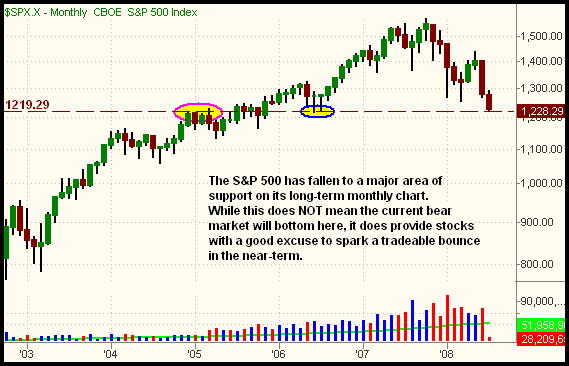| The Wagner Daily ETF Report For July 15 |
| By Deron Wagner |
Published
07/15/2008
|
Stocks
|
Unrated
|
|
|
|
The Wagner Daily ETF Report For July 15
The market got off to an encouraging start yesterday morning, but pressure from the persistent downtrend of the past six weeks caused excitement to quickly fade. After gapping higher on the open, traders immediately sold into strength, causing the major indices to trend steadily lower throughout the morning session. Stocks subsequently moved in a choppy, sideways range throughout the afternoon before finishing well in the red. Although the blue chip Dow Jones Industrial Average showed a bit of relative strength by losing just 0.4%, the benchmark S&P 500 Index shed 0.9%. The Nasdaq Composite fell 1.2%, as the small-cap Russell 2000 and S&P Midcap 400 indices dropped 1.6% and 1.0% respectively. Each of the main stock market indexes finished in the bottom quarter of its intraday range.
Turnover receded substantially from last Friday's above average volume levels, enabling the broad market to dodge what would have been the second straight day of institutional selling. Total volume in the NYSE declined 18%, while volume in the Nasdaq came in 15% lighter than the previous day's level. In both exchanges, declining volume exceeded advancing volume by a margin of approximately 3 to 1, certainly not ugly enough to indicate extreme levels of selling.
After getting pummeled over the past six weeks, where will the S&P 500 eventually find support? Though the daily chart looks rather ominous, the long-term monthly chart may shed some light on the situation. Take a look:

As the dashed horizontal line indicates, notice how the S&P 500 has fallen to support of the lows from June and July of 2006 (circled in blue). More importantly, those lows correspond to significant support from an area of prior highs (circled in pink). Many traders think that prior lows provide more price support than an area of prior highs, but this is not the case. Over the years, we've found that prior highs are more likely to hold the price of a stock or ETF than a dip to an area of prior lows. Just think about what formed support of lows from June and July of 2006 in the first place. It was that area of prior highs that we circled in pink. We're not suggesting that the S&P 500's current sell-off to this area of horizontal price support will mark the ultimate low of the current bear market. However, it is pretty likely this area will at least provide a decent bounce in the near-term.
Over the past two weeks, one could have easily justified the statement that stocks are "oversold," but placing aggressive buy orders purely on that assessment would have been a costly proposition. As we've warned about a few times over the past month, "oversold" markets often continue to become more "oversold" before buyers eventually step in. Price action since mid-June has been a perfect example of this. Blindly trying to guess where that reversal point will come, without first having some type of confirmation that a bottom is forming, can be very dangerous if strict risk parameters are not adhered to.
If you're worried about missing the tradeable bounce off the lows that will eventually come, but still want to respect risk, there is an easy way to put the odds in your favor. After a string of losing days, wait for the first session in which the major indices rally to close above the previous day's high. Then, wait for the first pullback to support of the 20-period moving average on the hourly chart. A protective stop is then placed below the intraday low of the "up" day that triggered the reversal of momentum. Historically, we've found this setup has a high percentage of accuracy for profitable trades, and also carries a positive reward/risk ratio.
Two of our three open ETF positions are showing solid gains (StreetTRACKS Gold Trust [GLD] and Biotech HOLDR [BBH]), while one is under pressure (Ultra Russell 2000 ProShares [UWM]). We dipped a toe in the water on the buy side of the market with our July 10 entry in UWM. The setup explained above is exactly what prompted our decision to buy UWM last week. At the time, UWM had perfectly pulled back to support of both its 20 and 40-period moving averages on the hourly chart, after reversing above the prior day's high two sessions prior. Obviously, no setup guarantees profitable trades, and UWM still may hit its protective stop, but having a firm, disciplined plan for re-entering the buy side of the market when selling momentum dries up is a great way to set yourself up for potential profits, without risk of getting steamrolled in the process.
Open ETF positions:
Long - GLD, BBH, UWM
Short - (none)
Deron Wagner is the Founder and Head Trader of both Morpheus Capital LP, a U.S. hedge fund, and Morpheus Trading Group, a trader education firm launched in 2001 that provides daily technical analysis of the leading ETFs and stocks. For a free trial to the full version of The Wagner Daily or to learn about Wagner's other services, visit MorpheusTrading.com or send an e-mail to deron@morpheustrading.com.
|